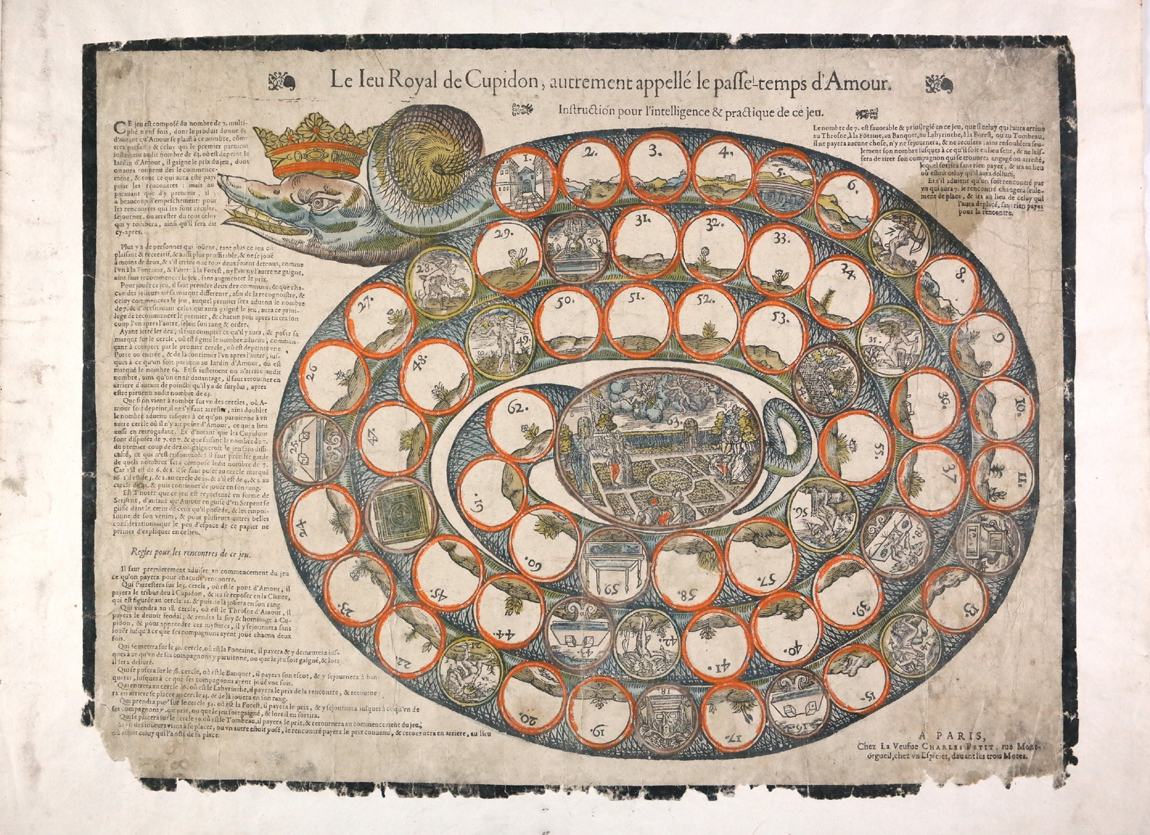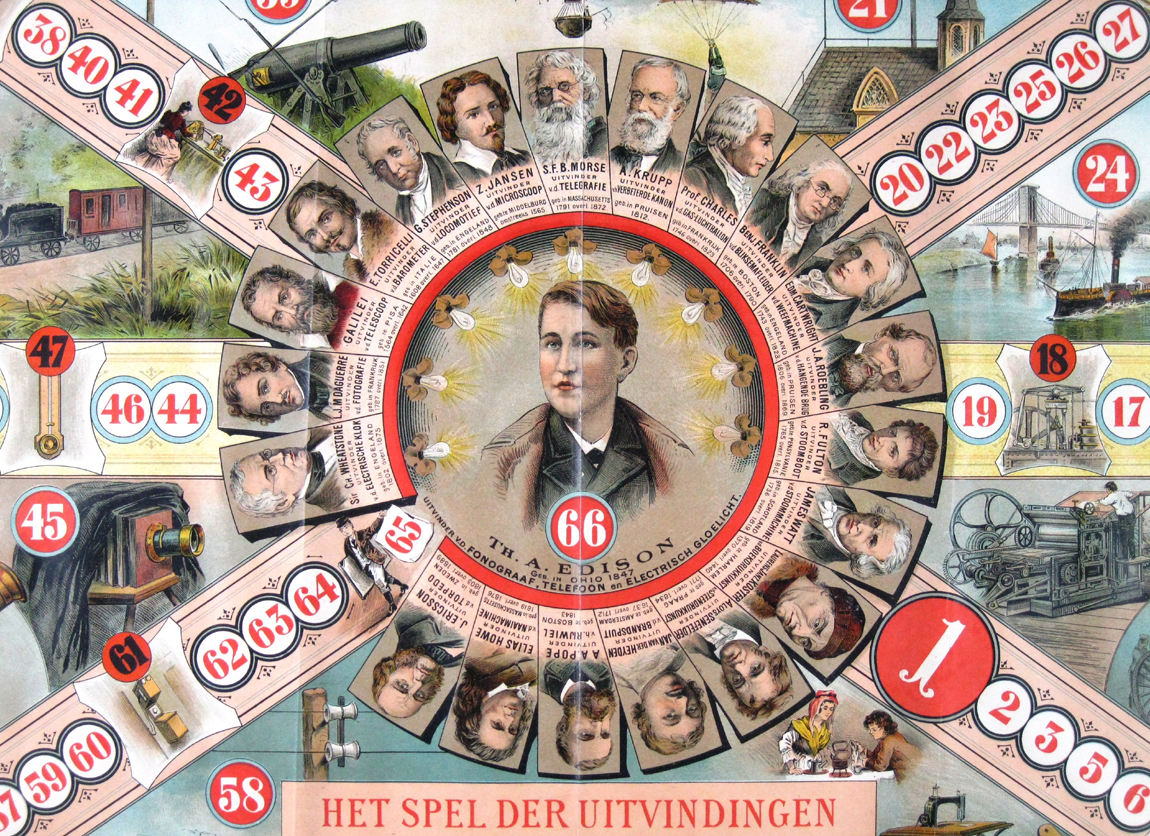NEW YORK CITY — The Royal Game of the Goose is one of the earliest printed board games, going back to the Middle Ages — and one of the simplest: just roll the dice and move along its spiral track. The graphically vibrant Grolier Club exhibition of the same name brings together more than 70 of these games, almost all from the extensive international collection of Adrian Seville, game board historian and emeritus professor, City University, London, and curator of this exhibition.

Jeu du skating-rink (The Skating Rink), Paris: Saussine Editeur, circa 1900, chromolithograph, 15¼ by 27 inches, on a three-panel folding board.
On view through May 14, these beautiful and striking printed games are hardly known in the United States, and Seville’s unique exhibition provides deep insights into the cultural history of Europe, with some fascinating glimpses of America, too.
The Royal Game of the Goose has been used as a template for thousands of variant games throughout Europe, ranging from the earliest educational games of the Seventeenth Century to games of advertising, politics and propaganda of the modern era.
Its name originates from the symbol of a lucky goose on the favorable spaces, while the unfavorable spaces are symbolized with the adversities of human life. The winning space in the classic goose game is on the “climacteric” number 63, reflecting medieval numerology. And if you hit “death” on space 58 you must begin again.

Le Ieu Royal de Cupidon (The Royal Game of Cupid), autrement appellé le passe-temps d’Amour, Paris: chez La Veufue [veuve] de Charles Petit, Rue Montorgueil, chez vn E[sp]icier deuant les trois Mores, printed circa 1640, probably from the woodblock of Charles Petit, active 1607–36, woodblock with original hand color au pinceau, 15¾ by 20½ inches.
Though the games are simple to play, most are not for young children. For example, a unique early Seventeenth Century print of the Game of Cupid has numerology representing the union of male and female; and its track is laid out on a fine crowned serpent to warn against sin.
Some games celebrate science and invention: one features Benjamin Franklin in Paris witnessing “the first balloon raised in the atmosphere by means of inflammable air,” while a Dutch game of the Nineteenth Century showcases Edison, prominently surrounded by his electric light bulbs.

Grand Jeu Du Bébé Jumeau (Game of the Baby Jumeau Dolls), Paris Amsterdam: Lith. Amand, 27 Rue Guénégaud, 1889, chromolithograph, 29 7⁄8 by 17 1⁄4 inches, laid onto two-panel folding board.
Others are from the early days of advertising, such as one in the shape of the newly built Eiffel Tower that promotes luxury French dolls but warns against buying cheap German imports — a broken German doll appears on the “death” space.
One section of the exhibition is devoted to images of America. A meticulously engraved game of the mid-Seventeenth Century shows remarkable images of the early Native American peoples. A novel by Jules Verne provides the basis for the Noble Game of the United States, in which the possible benefactors of a Chicago millionaire’s will battle for the money by competing in a gigantic goose game ranging across the States of the Nation.
The final case of the exhibition presents some games of human life arranged for play — do you have what it takes to progress from errand boy to successful banker and valued citizen?
As befits the Grolier Club, there is a full range of printing techniques from early woodcut to fine engraving and modern lithography. Some games were issued as broadside sheets, others are folded on linen or on pasteboard. Not all the games follow the classic template exactly, but all can trace their existence to the parent Game of the Goose.
A fully illustrated color catalog accompanies the exhibition, designed by Rob Banham (Reading University, England), with an introduction by Grolier Club past president William H. Helfand.
Events scheduled in connection with the exhibition include free guided tours, offered on every Tuesday from 1 to 2 pm throughout the run of the exhibition. On Tuesday, April 5, from 1 to 5 pm, the Grolier Club will sponsor a symposium on “Some Beautiful Board Games,” with a reception following. The symposium showcases the great diversity and appeal of board games through the ages and across the world. Speakers and their topics include Irving Finkel, British Museum, “The Royals Game of Ur”; Ann Dunn-Vaturi, Metropolitan Museum of Art, “Hounds and Jackals”; Alex de Voogt, American Museum of Natural History, “Mancala”; Adrian Seville, City University, London, “Two Fine Goose Boards”; Andrea Immel, Cotsen Library, Princeton University, “The Game of the Dolphin”; Margaret K. Hofer, New-York Historical Society, “Bulls and Bears: The Great Walls Street Game.”

Detail of C.J. Koster, Het Spel Der Uitvindingen (The Game of Invention), Amsterdam: Gebrs Koster, 1894, chromolithograph, printed by Amand, 22 by 27½ inches.
To register, contact Maev Brennan, 212-838-6690 or email mbrennan@grolierclub.org.
The Grolier Club is at 47 East 60th Street; it is free and open to the public, Monday–Saturday, 10 am 10 5 pm. For general information, 212-838-6690 or www.grolierclub.org.

